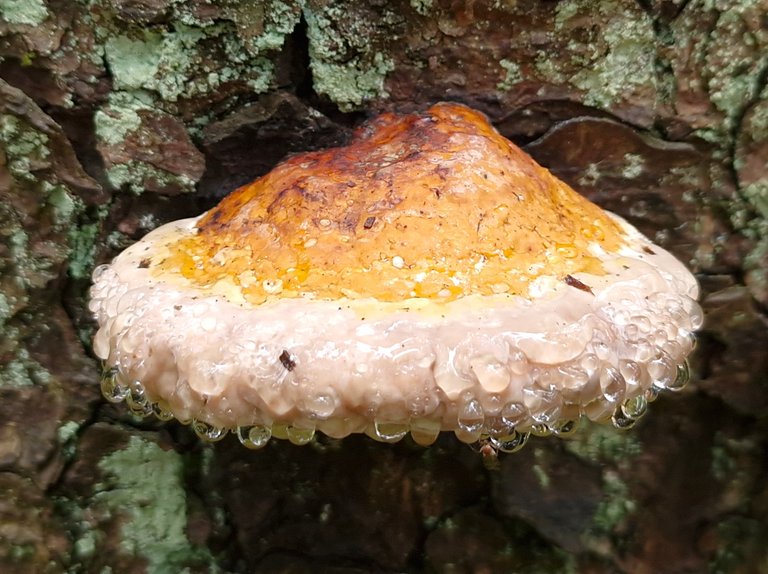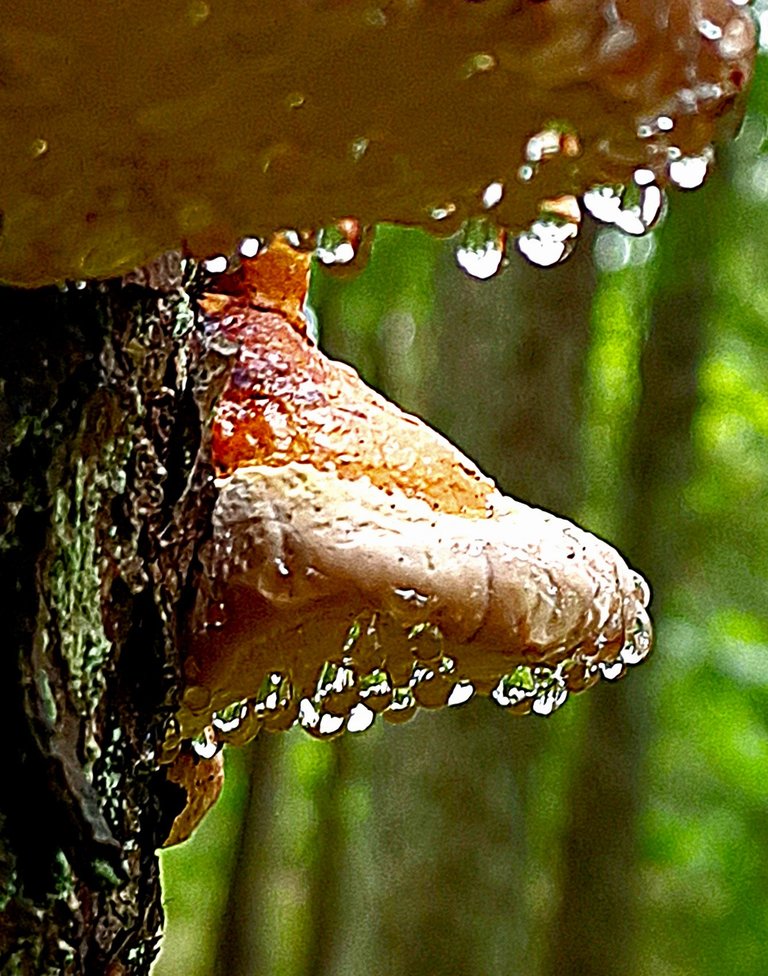some fascinating insights re: Fomitopsis pinicola
this is my contribution to #FungiFriday by @ewkaw

Fomitopsis pinicola Red-belted conk is one of the most common fungi in many northern forests. but being common by no means makes it any less interesting.
First, there's the tendency for copious weeping or sweating, or the more scholarly term guttation which not only looks amazing but has fascinating ecological functions. the conk itself has several medicinal properties long known in Chinese and Korean traditional medicine- anti-cancer, anti-oxidant, anti-inflammatory.

more recent research indicates that the liquid which is exuded via guttation also has medicinal value and not only for humans. basically, guttation is the means by which the fungi excrete excess water but there are other chemicals in the liquid. it is somewhat acidic. there are strong indications that honey bees access the low ph liquid in order to rid themselves of the pest Varroa mites. Honey has an average ph of 3.9 so despite it's sweet taste it is quite acidic. obviously bees can tolerate the acidity of the excreted liquid from the fungi but apparently the mites cannot.

so now fungal extracts, including from F. pinicola are given to bees commercially not only for treatment of Varroa mites but a number of other pests and thereby increase the longevity of the bees and preventing bee hive collapse.



Fomitopsis pinicola are brown rot fungi, that means they break down and digest the cellulose in the wood but not the lignin.
 a log with brown rot will typically look something like this. wood is mostly composed of cellulose, lignin and hemicellulose. cellulose are long chains of glucose molecules that are linked together end to end. the fungi excrete enzymes which break the chains, leaving available glucose (sugar) to be absorbed and digested. and that is how they get the energy needed to survive and grow.
a log with brown rot will typically look something like this. wood is mostly composed of cellulose, lignin and hemicellulose. cellulose are long chains of glucose molecules that are linked together end to end. the fungi excrete enzymes which break the chains, leaving available glucose (sugar) to be absorbed and digested. and that is how they get the energy needed to survive and grow.
it is fascinating that fungi are more like animals than plants. they have to eat to get energy whereas plants make their own through photosynthesis. Fungi release both water and carbon dioxide just as animals and we humans do when we exhale. more on that in some future post.
 while the cellulose is gone the brown lignin remains, hence the name brown rot. while lignin is also composed of carbon, hydrogen and oxygen just like cellulose, the bonds are far more complex giving wood it's rigidity. of course there are fungi capable of breaking down lignin also but that will also have to be in another post.
while the cellulose is gone the brown lignin remains, hence the name brown rot. while lignin is also composed of carbon, hydrogen and oxygen just like cellulose, the bonds are far more complex giving wood it's rigidity. of course there are fungi capable of breaking down lignin also but that will also have to be in another post.
in commercial forests and orchards brown rot fungi, especially (due to the fact that it is so common) Fomitopsis pinicola may be regarded as a destructive disease but in nature they perform vital functions in the forest ecology and carbon cycles by releasing organic matter into the soil and making it available for new growth. in that process they also influence soil chemistry improving conditions for increased biodiversity.
i am not a biologist or anything like that but i have studied mushrooms and ecology as a hobby long enough to know that all the fungi you see are amazing life forms. the more i learn the more i respect them for what they are and what they do.
sources:
https://patents.google.com/patent/US9474776B2/en
https://www.fungimag.com/fall-2010-articles/mushroom-weepLR.pdf
https://pmc.ncbi.nlm.nih.gov/articles/PMC7146440/
https://esj-journals.onlinelibrary.wiley.com/doi/10.1111/1440-1703.12260
thanks so much for the curation
!NDEED
Hello sir @eolianpariah2
What a beautiful mushroom you have found, I love its shape and the color combination
You have a lot of knowledge about them,
beautiful photographs
https://www.reddit.com/r/FairytaleasFuck/comments/1n5mxb8/put_7_drops_in_his_drink_every_evening_for_7_days/
This post has been shared on Reddit by @eolianpariah2 through the HivePosh initiative.